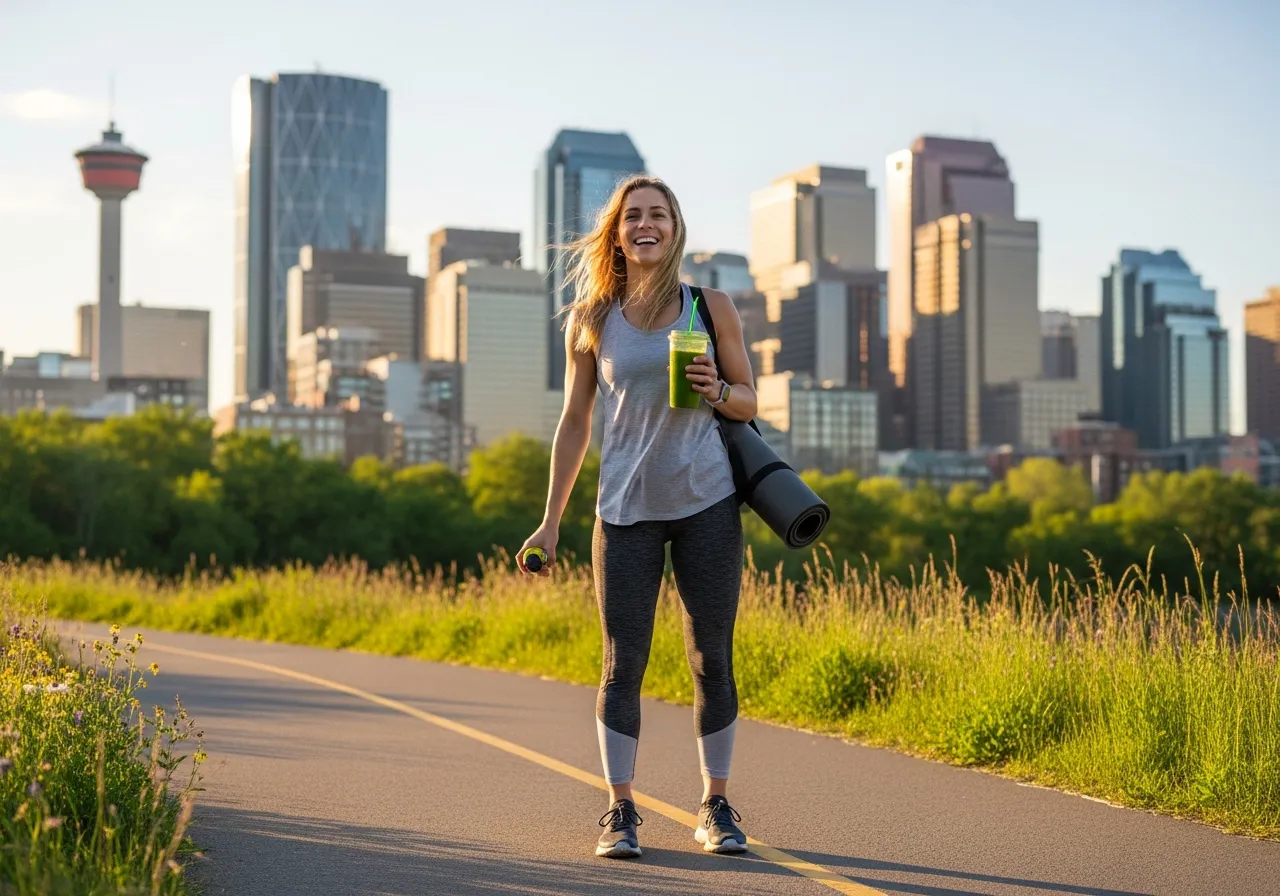Calgary consistently earns recognition as one of Canada's healthiest cities, and once you understand our unique combination of natural advantages and urban amenities, it's easy to see why. Living at the gateway to the Canadian Rockies provides unparalleled access to outdoor recreation, while our city's forward-thinking approach to urban planning has created over 1,000 kilometers of pathways that weave through neighborhoods, connecting residents to nature and each other.
What sets Calgary apart from other major Canadian cities isn't just our proximity to world-class hiking, skiing, and mountain recreation—though being an hour from the Rockies certainly doesn't hurt. It's the integration of wellness into daily life that makes healthy living feel natural rather than forced. From the extensive pathway system that lets you bike to work along the Bow River to the thriving farmers' markets that make eating locally both convenient and affordable, Calgary's infrastructure supports healthy choices at every level.
Calgary's Distinctive Fitness Culture
Fitness in Calgary goes far beyond traditional gym memberships, though the city certainly offers excellent indoor facilities. The real magic happens when you embrace Calgary's outdoor lifestyle, which adapts seamlessly through our dramatic seasonal changes. The extensive pathway system isn't just for leisurely weekend strolls—it serves as a genuine transportation network that many Calgarians use for daily commuting, turning necessary travel into fitness opportunities.
During summer months, the city transforms into an outdoor fitness paradise with 16-plus hours of daylight providing endless opportunities for activity. The Bow River pathway becomes a highway of cyclists, runners, and rollerbladers, while parks throughout the city host outdoor bootcamps, yoga sessions, and running clubs. The proximity to Kananaskis Country and Banff National Park means world-class hiking and mountain biking are accessible for evening after-work adventures, not just weekend escapes.
Winter Fitness: Embracing the Season
Calgary's approach to winter fitness sets it apart from other Canadian cities that treat cold months as something to endure rather than enjoy. The frequent chinook winds that melt snow and raise temperatures create windows of mild weather perfect for outdoor activity, while the city maintains its pathway system for year-round use. Cross-country skiing becomes accessible right within city limits, with groomed trails in parks like Fish Creek and Bowness.
The indoor fitness scene thrives during winter months, with climbing gyms, yoga studios, and specialized fitness centers distributed throughout every neighborhood. Many facilities focus on functional fitness that complements outdoor activities—building strength for ski season or maintaining cycling fitness for early spring riding. The key insight for newcomers is that Calgarians don't hibernate during winter; they adapt their fitness routines to embrace seasonal variety.
Community-Driven Activity
What makes Calgary's fitness culture particularly sustainable is its community aspect. Running clubs meet year-round, cycling groups organize rides for every skill level, and hiking clubs provide social connections alongside physical activity. The November Project, outdoor bootcamps, and seasonal sports leagues create accountability and friendship networks that extend far beyond exercise sessions.
This community approach helps newcomers integrate into Calgary's active lifestyle while providing long-term residents with motivation and variety. Whether you're interested in competitive cycling, recreational hiking, or simply want to walk with others, Calgary's fitness community offers entry points for every interest and ability level.
Nutrition and Calgary's Evolving Food Scene
Calgary's nutrition landscape has transformed dramatically over the past decade, evolving from a meat-and-potatoes oil industry town to a sophisticated food scene that balances Alberta's agricultural heritage with contemporary wellness trends. The proximity to some of Canada's best agricultural land provides access to exceptional locally-produced food, while the city's diverse population has created demand for varied, health-conscious dining options.
The Calgary Farmers' Market stands as the crown jewel of local food access, operating year-round and featuring over 80 vendors offering everything from organic vegetables grown in Alberta's rich soil to grass-fed beef from nearby ranches.. Beyond the obvious fresh produce, you'll find artisanal products like cold-pressed oils, fermented foods, and specialty items crafted by local producers who understand Alberta's unique growing conditions and consumer preferences.
Climate-Specific Nutrition Needs
Living in Calgary presents unique nutritional challenges that standard dietary advice often overlooks. The high altitude and low humidity increase hydration needs significantly—most residents require 2.5-3 liters of water daily, more during outdoor activities. The dry air and elevation affect metabolism and appetite in ways that many newcomers don't anticipate, often leading to increased calorie needs during the adaptation period.
Winter presents particular challenges with reduced sunlight leading to vitamin D deficiency for many residents. The combination of short days and indoor heating creates conditions where supplementation becomes necessary rather than optional. Many local health food stores and pharmacies stock high-potency vitamin D specifically for Calgary's climate conditions, and local healthcare providers routinely test and recommend appropriate dosing.
Seasonal eating becomes not just a preference but a practical necessity in Calgary. Summer's abundant local produce—berries, leafy greens, and root vegetables—provides antioxidants needed to combat increased UV exposure at altitude. Winter nutrition shifts toward warming, nourishing foods that support energy levels during shorter days and colder temperatures. Understanding these seasonal rhythms helps residents maintain optimal health year-round.
Local Food Resources
Beyond farmers' markets, Calgary offers numerous resources for healthy eating that reflect the city's commitment to wellness. Community gardens throughout neighborhoods provide opportunities for residents to grow their own food while learning about gardening in Alberta's unique climate. Many apartment buildings and condominiums now include rooftop gardens or shared growing spaces.
The restaurant scene has embraced farm-to-table concepts with establishments featuring locally-sourced ingredients and seasonal menus. Health-focused restaurants aren't relegated to niche markets—they're mainstream options found in every neighborhood. From juice bars specializing in cold-pressed nutrients to restaurants featuring grass-fed Alberta beef and organic vegetables, healthy dining has become accessible and affordable.
Grocery access has improved significantly with multiple organic and natural food stores, while conventional supermarkets now dedicate substantial space to organic, local, and specialty dietary products. The competition has driven prices down while improving quality and selection, making healthy eating more accessible to residents across income levels.
Self-Care and Mental Wellness in Calgary
Calgary's approach to self-care reflects the city's pragmatic yet progressive character—combining traditional wellness practices with innovative treatments while maintaining accessibility and authenticity. The mental health landscape has evolved to address the specific challenges of living in a climate with extreme seasonal variation, high-pressure industries, and rapid urban growth.
Seasonal Affective Disorder affects a significant portion of Calgary residents due to shortened winter daylight hours and extended cold periods. However, the city's wellness community has developed comprehensive approaches to managing seasonal mental health challenges. Light therapy clinics, specialized counseling services, and community programs specifically address these concerns while providing practical tools for thriving during difficult months.
The Medical Aesthetics and Wellness Industry
Calgary's medical aesthetics and spa industry has grown to become one of the most sophisticated in western Canada, offering treatments that go far beyond vanity to address real wellness concerns. Services like IV therapy help combat dehydration and nutrient deficiency common in our climate, while treatments like cryotherapy and infrared sauna therapy provide recovery benefits for active residents.
The integration of medical and cosmetic services reflects Calgary's practical approach to wellness—addressing both functional health and confidence-building treatments under professional medical supervision. From massage therapy that treats both stress and sports injuries to medical aesthetic treatments that boost confidence while addressing skin damage from environmental exposure, the industry serves genuine wellness needs.
Mental health services have expanded to include innovative approaches like float tanks for stress relief and meditation, EMDR therapy for trauma processing, and specialized counseling for industry-specific stressors common in Calgary's economy. The city's healthcare system has recognized that mental wellness requires diverse approaches and has supported expansion of services accordingly.
Community and Social Wellness
Calgary's social wellness infrastructure centers around community connection and shared activities that combat isolation while promoting health. Recreation centers in every quadrant offer not just fitness facilities but social programming that brings residents together around common interests. From seniors' programs to youth sports leagues, these centers serve as community hubs that address social wellness alongside physical health.
The volunteer culture in Calgary provides numerous opportunities for residents to contribute to community wellness while building personal connections. Environmental cleanup groups, community garden volunteers, and sports league organizers create networks of social support that enhance individual and community resilience.
Calgary's festival and event culture—from the Stampede to numerous neighborhood festivals—provides regular opportunities for community celebration and connection. These events serve mental wellness functions by creating shared experiences and cultural identity that help residents feel connected to something larger than individual concerns.
Adapting to Calgary's Climate for Optimal Health
Successfully living healthy in Calgary requires understanding and adapting to environmental factors that don't exist in more temperate climates. The combination of high altitude, extreme temperature variations, low humidity, and intense UV exposure creates unique challenges that affect every aspect of wellness from hydration to skin health to energy levels.
Hydration becomes a year-round priority rather than just a summer concern. The dry air and altitude increase fluid needs significantly, while indoor heating during long winters further depletes moisture from both air and body. Many residents find that standard hydration recommendations prove insufficient and require increased water intake along with attention to electrolyte balance, particularly sodium and potassium levels that affect cellular hydration.
Skin Health as a Wellness Foundation
Skin health in Calgary extends far beyond cosmetic concerns to fundamental wellness issues. The combination of intense UV exposure, low humidity, and temperature extremes can compromise skin barrier function, leading to chronic inflammation, sensitivity, and accelerated aging. Addressing these concerns requires both protective strategies and corrective treatments that account for environmental stressors.
Daily sun protection becomes essential year-round, not just during obvious sunny weather. Snow reflection during winter months can create UV exposure equivalent to beach conditions, while high altitude intensifies radiation even on cloudy days. Many residents underestimate winter UV exposure, leading to unexpected sun damage during activities like skiing or winter hiking.
The medical aesthetic industry in Calgary has developed specialized approaches to treating climate-specific skin concerns. Treatments like injectable hydration boosters, customized chemical peels, and laser therapy address environmental damage while strengthening skin's ability to handle ongoing climate stressors. These aren't vanity treatments but functional interventions that support overall health and comfort.
Energy and Metabolic Adaptation
Calgary's climate affects energy levels and metabolism in ways that many residents don't initially recognize. The altitude increases metabolic rate as the body works harder to process oxygen, while temperature extremes require additional energy for thermal regulation. Seasonal light variation affects circadian rhythms and hormone production, influencing everything from sleep quality to appetite regulation.
Understanding these metabolic effects helps residents adjust nutrition and activity levels appropriately rather than fighting against natural adaptation processes. Winter often requires increased caloric intake to maintain energy levels and body temperature, while summer's extended daylight can disrupt sleep patterns if not managed properly.
Many residents find that supplement protocols need adjustment when moving to Calgary. Iron levels may require monitoring due to altitude effects on red blood cell production, while vitamin D supplementation becomes essential rather than optional during winter months with limited sunlight exposure.
Building Your Personal Calgary Wellness Strategy
Creating a sustainable wellness routine in Calgary requires balancing the city's unique advantages with its environmental challenges while building systems that adapt to dramatic seasonal changes. The key is developing flexibility that allows you to maintain healthy habits regardless of weather conditions while taking advantage of Calgary's exceptional outdoor opportunities when conditions permit.
Start by establishing non-negotiable daily practices that work regardless of external conditions—indoor movement options, hydration routines, and stress management techniques that function whether it's -30°C or +30°C outside. Build these foundations first, then layer on seasonal activities and outdoor pursuits that enhance rather than replace your basic wellness framework.
Seasonal Adaptation Strategies
Successful Calgary residents develop wellness routines that flow with seasonal changes rather than fighting them. Summer strategies focus on maximizing outdoor activity during extended daylight hours while protecting against intense UV exposure and dehydration. This might mean shifting workout times to early morning or late evening, increasing water intake significantly, and building sun protection into daily routines.
Winter adaptation requires different strategies focused on maintaining energy and mood during shortened daylight hours while embracing rather than avoiding outdoor activity. This includes light therapy protocols, vitamin D supplementation, cold-weather activity gear, and indoor backup plans that prevent fitness routines from completely derailing during extreme weather periods.
The transition seasons—spring and fall—offer opportunities to reset and adjust routines while taking advantage of mild weather for outdoor activities and seasonal food availability. These periods work well for intensive health programs, detox protocols, or major routine changes while weather conditions remain comfortable.
Leveraging Calgary's Wellness Resources
Calgary's wellness infrastructure provides exceptional resources that many residents underutilize. The pathway system serves as a free outdoor gym that connects every area of the city, while recreation centers offer affordable fitness options in every neighborhood. Community gardens, farmers' markets, and volunteer opportunities provide social connection alongside health benefits.
The medical and wellness services available in Calgary rival those of much larger cities, from specialized sports medicine clinics to innovative mental health treatments. Learning to navigate and utilize these resources effectively can dramatically improve quality of life while managing the unique challenges of Calgary's environment.
Professional support becomes particularly valuable for newcomers adapting to Calgary's climate and lifestyle. Working with healthcare providers, fitness professionals, or wellness coaches familiar with Calgary's specific challenges can accelerate adaptation while preventing common mistakes that derail health goals during the adjustment period.
Frequently Asked Questions
Thriving in Calgary's Unique Wellness Environment
Healthy living in Calgary isn't about perfection—it's about adaptation, balance, and embracing the unique advantages our city offers while intelligently managing its challenges. The combination of world-



